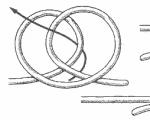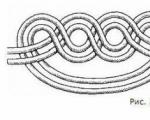Economic sphere. productive forces. The subject and means of labor. Productive forces and production relations Means of labor are called
General patterns of production processes (elements and structure)
The implementation of technology is possible only if there are three components: the object of labor; tools and means of labor, the labor process.
The subject of labor - a material object to which human labor is applied. The objects of labor are raw materials, semi-finished products, basic and auxiliary materials.
Raw material constitutes the initial material basis for the production of any product, which undergoes physical and (or) deeper transformations in the labor process. Usually, raw materials are understood as products of the extractive industry and agriculture. So, in metallurgy, ores are classified as raw materials, in coke production - coal, V agriculture - harvested crop, in the food industry - whole-milk products.
Semifinished- a product that has been processed at one or more sites within a single production process and must be transferred to other sites of the same production (enterprise) for final processing. Semi-finished products constitute the work in progress of the enterprise, do not have a selling price.
Basic materials- raw materials that have already undergone processing, which have become a finished product, which, however, is the object of technological processing at other enterprises. The main materials belong to the completed production and have a selling price. Usually they include products of the manufacturing industry (metals, lumber, yarn, cement, etc.).
Auxiliary materials contribute to the production of finished products without defining its essence. They either add to raw materials and basic materials to give them additional consumer properties (dyes), or contribute to the optimal conduct of the technological process (catalysts, fluxes). In accordance with the definition, auxiliary materials also include fuel and electricity, however, according to the accepted system of accounting and planning they are placed in a separate group.
A clear boundary between raw materials, semi-finished products, basic and auxiliary materials, as well as between certain specific substances in general view does not exist. Thus, limestone serves as a raw material for the production of lime and as an auxiliary material (flux) in a number of metallurgical processes. Lime is a semi-finished product for the production of calcium oxide, the main material in the manufacture of building products, an auxiliary material for cleaning Wastewater, the final product as mineral fertilizer. Cast iron processed within one enterprise into steel is a semi-finished product, and when shipped to a consumer, it is a finished product.
Tools - these are material objects that directly affect the object of labor during its processing. These include working machines and equipment (metal-cutting machines, melting and heating furnaces, etc.), as well as mechanisms for moving ore objects in the production process (conveyors, conveyors, cranes, etc.).
Means of labor - material objects that do not directly affect the object of labor during its processing, but contribute to the normal implementation of the technological process. The means of labor include industrial buildings and engineering structures, as well as power plants, transmission and other devices.
Industrial buildings- these are the buildings of the main and auxiliary workshops, laboratories (they have working machines and equipment), as well as all the premises that directly serve the main production (offices, garages, warehouses, depots, etc.).
engineering structures- these are various engineering and construction objects that contribute to the implementation of auxiliary technological processes. These include overpasses, cooling towers, galleries, bunkers, treatment facilities, tanks, etc.
Power plants- equipment for the production or conversion of energy. It includes a variety of engines, steam engines, turbines, electric generators, compressors, electric transformers, etc.
Transfer devices designed to supply electrical, thermal, mechanical energy from motor machines to working machines. This group consists of power lines, air and steam pipelines, gas and water distribution networks, transmissions, etc.
Work (the expenditure of the physical strength of the worker, mental and nervous efforts) is the basis of any technological process. Labor costs are measured by its duration, i.e. the time during which it is carried out. Labor costs are closely related to the concept of "labor productivity".
Labor productivity - the amount of working time required for the manufacture of a unit of output, or the amount of production created per unit of time.
The end result of the technological process is the finished product.
Finished products - products or material, the processing of which this enterprise completely finished, they meet the standards, are completed and can be sent to customers.
Finished products are divided into the main, which is the purpose of production, and by-products, obtained along the way.. For example, in blast-furnace production, the main product is cast iron, and by-products are blast-furnace slag and top gas. They are used in the national economy as one of the components in the production of cement (slag) and secondary energy resources (top gas).
In addition to the main and by-products, waste is generated in technological processes.
Waste at this stage of development, science and technology are not used as feedstock, either because they do not meet the requirements and their processing is not economically efficient, or because potential consumers are not psychologically and organizationally ready to process these wastes or are not aware of their presence . In many cases, waste producers also do not have information about the existence of their potential consumers.
On the subject of labor industry is divided into mining and processing.
Extractive industry engaged in the extraction of raw materials from natural, natural reserves. The subject of labor in it are minerals.
processing industry transforms the products of the extractive industry (syrve) as well as its own products (basic materials) into goods with a higher degree of processing. The ratio of the mining and manufacturing industries in Russia in 1995 was 24:76 and had an upward trend.
By use finished products industry is divided into two groups: A and B. Group A produces mainly tools and means of labor, group B produces consumer goods (light, food industry and so on.).
Until recently, group A accounted for 75/o of industry in our country. In post-industrial countries, approximately the same share (60-80%) falls on group B, which makes it possible to satisfy the demands of society in consumer goods and services, while simultaneously providing the necessary technical level and development of the material base of the industries of group B. An excessive share of group A is characteristic of the development trend production for the sake of the needs of production itself, without proper satisfaction of the consumer needs of the population (to make steel for the sake of steel, in order to make steel again).
Industry, together with agriculture and industrial infrastructure (transport, communications), trade, consumer services and utilities, constitute production area National economy countries.
In the non-manufacturing area includes science, art, education, health care, state machine administration, army and some other structures.
absent
4 Technological schemes production: composition and analysis of their structure
The structure of the object of labor includes the subject, means, conditions, goals of labor, etc.
The subject of labor- a system of properties and relationships of things, phenomena, processes, which a person carrying out a given labor activity must mentally or practically operate.
Purpose of labor- the result that society requires or expects from a person.
Goals of professional work
“The purpose of labor is a conscious image end result, to which a person aspires in the course of his expedient activity. In other words, we can say that the purpose of labor is an idea of the desired future.
The desire to achieve the set goal directs the action, determines the choice possible ways achievements, encourages the search for new actions. The goal is formed in the mind of a person as answers to the questions "What should I do?", "What should I succeed?", "What should I avoid?", "What actions should I take to get the desired result?"
During work, the consciousness of a person is always filled with acts of assessing the situation, comparing the real course of affairs with the idea of \u200b\u200bwhat should happen.
Goals labor activity infinitely varied; they can be reduced to six large groups: gnostic (cognitive), transformative (four groups), exploratory.
Working conditions- features of the environment in which human work takes place, their main types (manual, mechanized; machine-manual; automated and automatic; human functional means as tools of labor).
Working conditions
One of the most important and most multifaceted psychological features of labor is its conditions. The following types of working conditions are distinguished: 1) ordinary microclimatic: a) indoors - domestic, b) on outdoors; 2) unusual, causing psychophysiological tension: a) risk to life, b) complex emergency situations requiring quick necessary actions, c) communication with offenders, mentally ill and persons with various deviations and defects, d) a clearly defined rhythm and pace, e) physical activity, f) prolonged stay in one position (static working posture), g) night shifts, h) specific conditions (temperature, humidity, chemical hazards, vibration, noise, height, depth).
Means of labor in professional activities
“Means of labor are a necessary component of the labor process. Under the means of labor understand the tools with which a person acts on the object of labor. The means of labor act as a kind of continuation of the natural human organs used in the labor process. Among the tools of labor there are not only things, but also something immaterial - speech, behavior, etc.
Tools of labor are very diverse. Despite this, they are all divided into two groups: real and non-real.
Real tools of labor. Material tools include: manual and mechanized tools; machines (mechanisms), automatic devices, automated means; devices, measuring devices.
Hand tools. The very name "hand tools" comes from the main organ of labor - the human hand. Hand tools have always been and remain in labor as long as a person is alive and able to work. At any level of technological progress, equipment will need to be assembled and assembled by skillful hands.
They include simple manual, mechanized processing tools and fixtures. Simple hand tools are: a screwdriver, a scalpel (surgical knife), a chisel (a tool for engraving on wood or metal), a bush hammer (one of the tools of stone carvers), trimming (a type of paint brush), a file, a chisel, a hammer, etc. .
Machine tools. Technical devices that completely or partially replace a person in terms of the methods of converting materials, distributing energy or information are called machines (mechanisms).
Automated means of labor. These are such means that, being set in motion, perform a certain work without human intervention, i.e. at certain stages of the labor process, they completely replace a person, automatically managing the production process. A person only observes the operation of the equipment and controls its correctness and quality. Automatic tools include: automatic, semi-automatic, automatic lines, robotic complexes, devices for performing long-term continuous hidden processes, including technological ones, proceeding at great speed.
Instruments and devices. This is a separate group of means of labor. They are designed to enhance the cognitive functions of a person at work. Most of them are imaging devices: microscopes, binoculars, telescopes, aerial cameras (for topographic surveys of the earth's surface), X-ray machines, flaw detectors, closed-circuit television systems for video monitoring technological processes occurring in conditions inaccessible to humans (under water, in space, in aggressive environments, etc.). There are devices that provide information in the form of conditional signals, numbers, letters, light and sound indicators: chronometers, stopwatches, thermometers, pulse counters, various electrical measuring instruments (ammeter, voltmeter, ohmmeter, avometer, wattmeter), calipers, micrometers, etc. a separate subgroup is allocated technical means voice transmission (information, orders, commands): telephones, megaphones, emergency light scales, alarm bells, video telephones, television systems, musical instruments. Recently, devices for processing information have become widespread: computers, automatic reference installations, recalculation tables, printing, reading, recording and transmitting devices.
Non-material (functional) tools of labor. Intangible means are usually called functional. The fact is that these means of labor are associated with the manifestation of human functions, such as speech, gestures, facial expressions. Their peculiarity lies in the fact that you cannot touch these means of labor with your hands and you cannot see with your eyes, which usually causes great difficulties in the analysis of the profession. And their awareness is associated with the assimilation of many new psychological concepts: sensory, kinesthetic, somatic, verbal, etc.
Functional tools of labor are mentally held ideas about the samples of the results of labor or a system of "sensory standards". They can be external in relation to consciousness and internal, entering consciousness and held in memory.
These tools are quite diverse, due to the richness of colors. inner peace a person manifested in behavior, facial expressions, gestures, speech, etc. They constitute a large group, which includes: 1) internal, functional sense organs, physiological organs of a person; 2) simple speech; 3) speech is emotional, expressive; 4) business, written speech; 5) behavior in simple forms manifestations - at the level of the whole organism as a whole; 7) behavior is predominantly business-like, impartial; 8) complex intellectual tools used to solve practical and theoretical problems.
different people; patience.")




